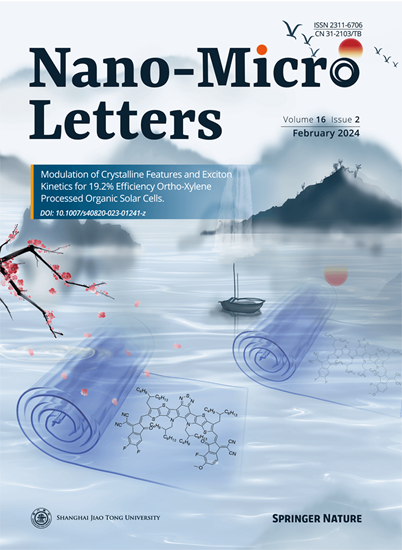光电子学中用于光管理的超薄竹绿色纤维素框架的生物启发精密剥离。
IF 36.3
1区 材料科学
Q1 Engineering
引用次数: 0
摘要
纤维素框架由于其优异的光散射能力和可持续性而成为光管理的有前途的材料。传统的生物质衍生纤维素框架面临着雾霾和透明度之间的基本权衡,加上不切实际的厚度(≥1毫米)。受鱿鱼剥皮机制的启发,这项工作开发了一种过氧甲酸(HCOOOH)支持的精确剥皮策略,以分离完整的10微米厚的竹绿色(BG)框架,比木材薄100倍,同时实现了前所未有的光学性能(88%的雾霾和80%的透明度)。这种性能优于去木质素生物质(1毫米透明度< 40%),与工程纤维素复合材料相匹配,但不需要能源密集型纳米颤动。保留的原生纤维素I的结晶结构(结晶度为64.76%)和蜡包覆的单轴纤维排列(Hermans因子:0.23)有助于高机械强度(903 MPa模数)和宽带光散射。作为多晶硅太阳能电池中的光管理层,BG框架将光电转换效率提高了0.41%(18.74%→19.15%),优于合成抗反射涂层。这项工作为下一代光电子技术中的光学级纤维素材料建立了一条可扩展的、废物转化为财富的途径。本文章由计算机程序翻译,如有差异,请以英文原文为准。
Bioinspired Precision Peeling of Ultrathin Bamboo Green Cellulose Frameworks for Light Management in Optoelectronics.
Cellulose frameworks have emerged as promising materials for light management due to their exceptional light-scattering capabilities and sustainable nature. Conventional biomass-derived cellulose frameworks face a fundamental trade-off between haze and transparency, coupled with impractical thicknesses (≥ 1 mm). Inspired by squid's skin-peeling mechanism, this work develops a peroxyformic acid (HCOOOH)-enabled precision peeling strategy to isolate intact 10-µm-thick bamboo green (BG) frameworks-100 × thinner than wood-based counterparts while achieving an unprecedented optical performance (88% haze with 80% transparency). This performance surpasses delignified biomass (transparency < 40% at 1 mm) and matches engineered cellulose composites, yet requires no energy-intensive nanofibrillation. The preserved native cellulose I crystalline structure (64.76% crystallinity) and wax-coated uniaxial fibril alignment (Hermans factor: 0.23) contribute to high mechanical strength (903 MPa modulus) and broadband light scattering. As a light-management layer in polycrystalline silicon solar cells, the BG framework boosts photoelectric conversion efficiency by 0.41% absolute (18.74% → 19.15%), outperforming synthetic anti-reflective coatings. The work establishes a scalable, waste-to-wealth route for optical-grade cellulose materials in next-generation optoelectronics.
求助全文
通过发布文献求助,成功后即可免费获取论文全文。
去求助
来源期刊

Nano-Micro Letters
NANOSCIENCE & NANOTECHNOLOGY-MATERIALS SCIENCE, MULTIDISCIPLINARY
CiteScore
32.60
自引率
4.90%
发文量
981
审稿时长
1.1 months
期刊介绍:
Nano-Micro Letters is a peer-reviewed, international, interdisciplinary, and open-access journal published under the SpringerOpen brand.
Nano-Micro Letters focuses on the science, experiments, engineering, technologies, and applications of nano- or microscale structures and systems in various fields such as physics, chemistry, biology, material science, and pharmacy.It also explores the expanding interfaces between these fields.
Nano-Micro Letters particularly emphasizes the bottom-up approach in the length scale from nano to micro. This approach is crucial for achieving industrial applications in nanotechnology, as it involves the assembly, modification, and control of nanostructures on a microscale.
 求助内容:
求助内容: 应助结果提醒方式:
应助结果提醒方式:


